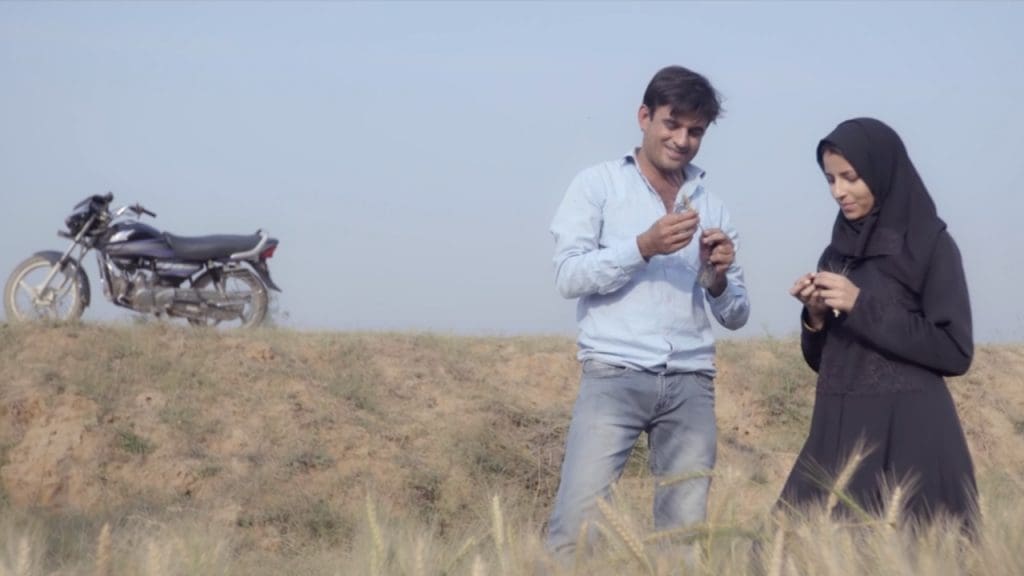
Aani Maani is a 2019 Indian drama film written and directed by Fahim Irshad, starring Farrukh Seyer, Priyanka Verma and Neha Singh in the lead roles. Three years after its release, the film remains a bit obscure and away from the commercial and literary spotlight. The plot revolves around a lower-middle-class Muslim family and how their lives change for the worse after the beef ban announcement in the state of Uttar Pradesh.
In the era of majoritarian hate and divisive politics, the Bollywood industry has blended well with the shades of saffron, furthering the stereotype of demonic and exotic Muslims as the ‘other’. They are painted as barbaric invaders of the medieval era who are unworthy of trust and inclusion in mainstream society. In such depressing times, Fahim Irshad’s film delivers a well crafted narrative and an honest representation of Muslim life in contemporary India.
The film’s opening scenes introduce us to the major characters as they go about their daily work. The protagonist Bhutto is a Kebab seller in Sambhal, Western Uttar Pradesh, who supports a family of five members that consists of his parents, wife, his sister and her four-year-old daughter.
Bhutto’s father Ikram Ahmed Khan is a man devoted to his community, who records public announcement messages in his leisure hours. Bhutto’s mother is a deeply sensitive and religious woman, who is a pillar of strength and laughter for everyone in the house. His wife, Tarannum is a young, rustic and open-hearted woman from the village, slowly settling into city life. Nazo, his sister, is divorced and stays at her parents’ house with her daughter, Aayat.
It is this four-year-old who is the source of joy in the family. Throughout the film, Aayat is visibly engaged in her doll games, running around and playing Aani Maani (a game in which one goes around in circles till they become dizzy and collapse on the floor). The family resides in an ancestral house that comprises small separate rooms, with a courtyard in the middle which is the common space for all gatherings and discussions. Through all this imagery, the filmmaker captures a small happy family in their own innocent world away from the fast-changing socio-political tides.
However, there is always a sense of anxiety and frustration that looms over the characters. Bhutto’s sister, Nazo, is constantly frustrated about her failed marriage and anxious about being labelled a liability. These evolving dynamics at home result in Bhutto’s wife’s demand for an independent house and his personal worries about expanding the business. As the story progresses and we learn about the state-wide beef ban imposed in Uttar Pradesh that wreaks havoc across working-class households. All these shared frustrations, anxieties and aspirations culminate in more misery for Bhutto and his family.
With the closure of illegal slaughterhouses and strict surveillance on small-scale meat traders, Bhutto looks at alternate means of obtaining meat. Despite his father’s stern and valid advice of laying low for some time, Bhutto is persuaded by the police to pay regular bribes and buy meat from the black market. Not ready to close his small flourishing business, he goes ahead with the idea against his father’s wishes which causes a lot of heated tension in the family. This leads them into a spiral of silence, fear and uncertainty.
The constant paranoia also brings out the worst of patriarchal/toxic masculine traits as is seen when Bhutto has a meltdown and hits his wife during an argument. He later feels guilty and apologizes. However, such a dominant display of aggression is well countered by a sense of shared solidarity amongst the womenfolk of the household. Such intense and sometimes hostile familial dynamics are reflective of the lived realities of Muslims and other vulnerable groups as they struggle to find ways of surviving.
The question and crime of belonging
Chadha and Kavoori elaborate on how by their tacit conflation of Islam with acts of violence against the Indian nation, Bollywood films since the 90s indicate that Indian Muslims are often supporters of Pakistan and have to prove their loyalty to the Indian nation-state. Maa Tujhe Salaam, Jaal, Hero, LOC Kargil and Indian are a few movies that reflect this idea. As Rai (2004) puts it, when the token “good” Muslims do appear on screen, they do not typically undertake the process of “claiming and performing” their allegiance to the Indian nation. They do this either by expressing their devotion to India through patriotic speeches or acts which translate into an assertion of inclusion in the national family.
By drawing a life-like portrait of a working-class Muslim man who neither indulges in performative nationalism nor follows the trope of ‘good Muslim-bad Muslim’ and for the same is ‘othered’ and considered an outsider, Fahim Irshad makes a conscious choice to point out the predicament that Indian Muslims find themselves in, in both real and reel life.
The film also cleverly draws parallels with the Batla House fake encounter and the subsequent arrests of young Muslim boys across North India on trumped-up charges by showing how Bhutto served an 8-year prison sentence on false charges. This and how his business collapses abruptly, signal Bhutto’s only crime; that of being a Muslim in India. Exhausted from paying enormous amounts of bribes at various police checkpoints, when Bhutto raises his concern with the Police STF team, they casually tell him to go to Pakistan. This sense of betrayal and apathy devoted to minorities today, especially Muslims, is captured with painful clarity in the film. The intellectual honesty and sincerity in conveying the aspirations of Muslims and the issues central to their community make Aani Maani a poignant and worthwhile watch.
The film is streaming on the independent streaming platform MUBI-India.
Abdullah Kazmi is a post-graduate Media Studies student at Hyderabad University.



